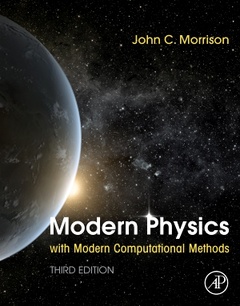Modern Physics with Modern Computational Methods (3rd Ed.) for Scientists and Engineers
Auteur : Morrison John

In this new edition, the differential equations that arise are converted into sets of linear equation or matrix equations by making a finite difference approximation of the derivatives or by using the spline collocation method. MATLAB programs are described for solving the eigenvalue equations for a particle in a finite well and the simple harmonic oscillator and for solving the radial equation for hydrogen. The lowest-lying solutions of these problems are plotted using MATLAB and the physical significance of these solutions are discussed.
Each of the later chapters conclude with a description of modern developments.
2. The Schrödinger Wave Equation
3. Operators and Waves
4. The Hydrogen Atom
5. Many-Electron Atoms
6. The Emergence of Masers and Lasers
7. Diatomic Molecules
8. Statistical Physics
9. Electronic Structure of Solids
10. Charge Carriers in Semiconductors
11. Semiconductor Lasers
12. The Special Theory of Relativity
13. The Relativistic Wave Equations and General Relativity
14. Particle Physics
15. Nuclear Physics
Physics, Physical Sciences & Engineering students
- Makes critical topics accessible by illustrating them with simple examples and figures
- Presents modern quantum mechanical concepts systematically and applies them consistently throughout the book
- Utilizes modern computational methods with MATLAB programs to solve the equations that arise in physics, and describes the programs and solutions in detail
- Covers foundational topics, including transition probabilities, crystal structure, reciprocal lattices, and Bloch theorem to build understanding of applications, such as lasers and semiconductor devices
- Features expanded exercises and problems at the end of each chapter as well as multiple appendices for quick reference
Date de parution : 12-2020
Ouvrage de 500 p.
21.5x27.6 cm
Thèmes de Modern Physics with Modern Computational Methods :
Mots-clés :
a MATLAB program for finding the lowest energy eigenvalues for finite well using a finite difference approximation of the derivatives; a MATLAB program for finding the lowest energy eigenvalues for the harmonic oscillator using spline collocation; average value of a function; f(x); eigenvalue equations; probabilities; solutions of the Schrödinger equation for a particle in a finite well; solutions of the Schrödinger equation for a particle in an infinite well; the operator corresponding to the momentum; the operators corresponding to other variables such as the energy; the Schrödinger equation; the wave functions of the simple harmonic oscillator
